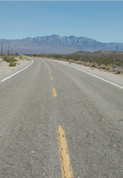
Scarcity and roads
The scarcity of resources in the California desert means that necessities must be imported, much of it on highways and roads criss-crossing the landscape.
Urban and Suburban Development
Since the 1980s, dramatic population growth in the California desert has been linked with suburban expansion.1 This growth has continued. San Bernardino County alone showed a population increase of 17.9 percent between 2000 and 2008 according to the U.S. Census Bureau.2 The town of Victorville (in San Bernardino County) experienced a population increase from 8,100 in 1962 to 60,650 in 1995, which was accompanied by an increase in the amount of developed area from 25 km2 to 175 km2 over the same time period.3 Because resources are limited in the California desert, residents import necessities such as food, water, and energy, resulting in a heavy reliance on fossil fuel-based transportation.4 Urban and suburban development and population growth increase the need for additional roads and transmission lines, as well as increased groundwater withdrawal and surface water diversion. These developments contribute to habitat fragmentation, with potential negative effects for wildlife and plants.
1 D.L. Hughson, “Human Population in the Mojave Desert: Resources and Sustainability,” in The Mojave Desert: Ecosystem Processes and Sustainability, ed. R.H. Webb, L.F. Fenstermaker, J.S. Heaton, D.L. Hughson, E.V. McDonald, and D.M. Miller, (Reno: The University of Nevada Press, 2009), 57-77.
2 U.S. Census Bureau, San Bernardino County QuickFacts, 2009, U.S. Census Bureau Quickfacts, http://quickfacts.census.gov/qfd/states/06/06071.html.
3 D.L. Hughson, “Human Population in the Mojave Desert: Resources and Sustainability,” in The Mojave Desert: Ecosystem Processes and Sustainability, ed. R.H. Webb, L.F. Fenstermaker, J.S. Heaton, D.L. Hughson, E.V. McDonald, and D.M. Miller, (Reno: The University of Nevada Press, 2009), 57-77.
4 D.L. Hughson, “Human Population in the Mojave Desert: Resources and Sustainability,” in The Mojave Desert: Ecosystem Processes and Sustainability, ed. R.H. Webb, L.F. Fenstermaker, J.S. Heaton, D.L. Hughson, E.V. McDonald, and D.M. Miller, (Reno: The University of Nevada Press, 2009), 57-77.
